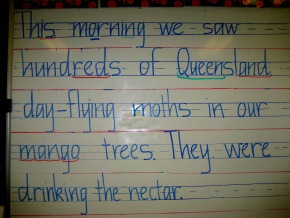“Have you seen the moths in the mango trees?” asks my colleague as she walks up the stairs.
“No. What moths?”
“Look out the window and you’ll see them.”
I look. I see. I grab my small camera and rush down the stairs.
Children, parents and teachers stand in awe of the hundreds of moths flying in and around the big mango trees. Unfortunately I cannot get good photos – the moths fly fast and rest little. I swing by the library for books on moths. Our resident expert on local wildlife tells us they are Queensland day-flying moths and she downloads and prints pictures from http://www.panoramio.com/photo/21949158
Soon after the bell I take the children to the mango trees – as do many teachers in our school. The moths flutter and fly in and around the mango trees stopping only to drink the sweet nectar.
We head back to the classroom all the while watching the moths. We talk. We write – shared writing is about the moths.
We read books about moths and make a chart about differences between butterflies and moths – but we do not find this moth in the books. Back to Google…
How are butterflies and moths different?
Butterflies Moths
*Usually fly in daytime *Usually fly at night
*Usually bright coloured wings *Usually dull coloured wings
*Rest with wings above their bodies *Rest with wings spread out flat
(from its back)
*Antenna may have a knob *Antenna may be ‘feather-like’ or plain at the end
at the end
*Slender, hairless bodies *Fat abdomen and furry bodies
We realise that this moth is called the Day-flying moth for a very good reason!




Leave a comment